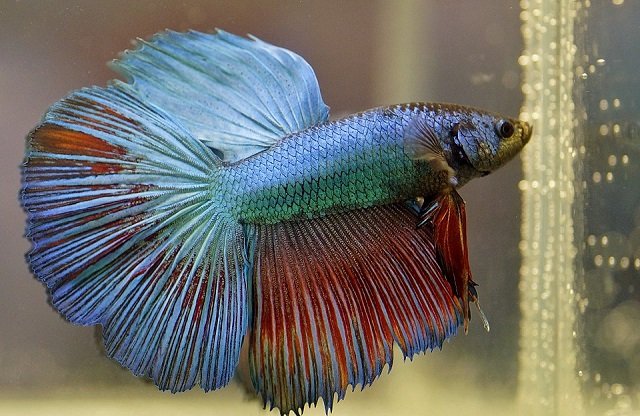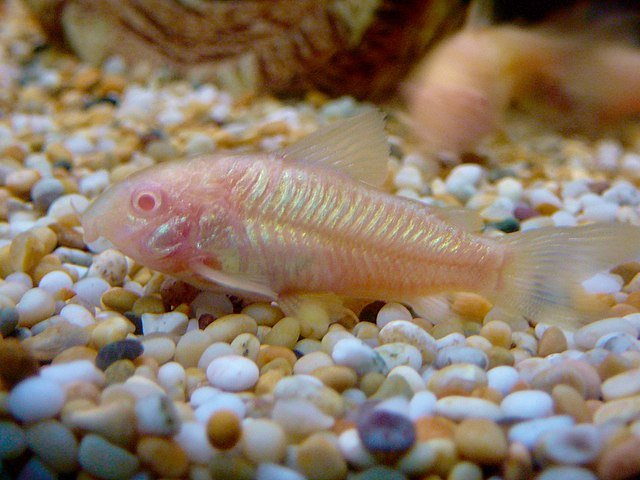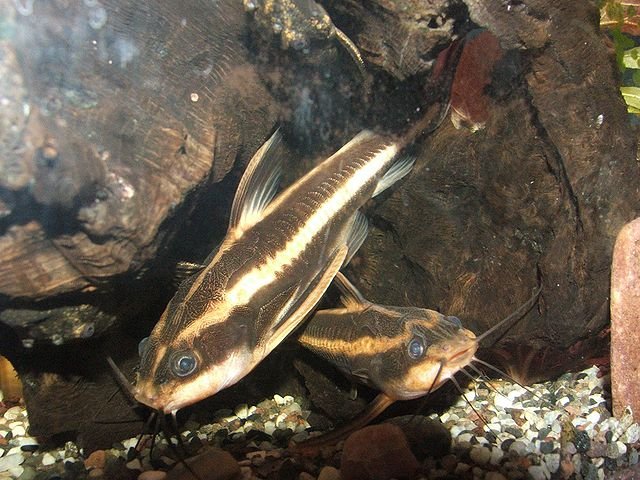The Ancistrus, commonly known as the “Bushymouth Pleco,” “Bristlenose Catfish,” or “Glass Cleaner Fish,” is one of the most popular and recognizable freshwater aquarium fish in the world of aquaristics. Belonging to the vast Loricariidae family, this Ancistrus catfish captivates not only with its unique appearance—featuring distinctive “bristles” or tentacles (odontodes)—but also with its valuable role as an algae eater. South American armored catfish (Loricariidae family) and cory catfish (Callichthyidae family) together account for 19.0% of all ornamental freshwater fish species imported into Europe (Novák et al., 2025).
If you’re considering adding an Ancistrus fish to your aquarium or simply want to learn more about this fascinating underwater inhabitant, this comprehensive guide will provide all the necessary information, from its basic biology to specific care, including its diet and the different varieties available, such as the clear Ancistrus, super red Ancistrus, and albino Ancistrus.
Taxonomy of Ancistrus
Ancistrus is a genus of nocturnal freshwater fish, native to South America and Panama. This genus comprises 58 valid species (De Oliveira et al., 2009):
- Kingdom: Animalia
- Phylum: Chordata
- Class: Actinopterygii
- Order: Siluriformes
- Family: Loricariidae
- Genus: Ancistrus
- Species: Ancistrus cirrhosus, A. dolichopterus, A. temminckii, A. triradiatus
- Common names in Spanish: Ancistrus, Pleco de Nariz Cerdosa, Limpiavidrios, Limpiafondos.
- Common names in English: Bushymouth Catfish, Ancistrus, Bushynose, Bristlenose Pleco.
The Loricariidae family is immense, containing hundreds of genera and thousands of armored catfish species native to Central and South America. Ancistrus fish stand out within this family due to several key features, the most notable being evertible interopercular odontodes (spines on the “cheeks” that can be extended) and, in mature males, the distinctive fleshy tentacles on the snout and head border. Regarding this, De Oliveira et al. (2009) highlights that the great karyotypic diversity among Ancistrus species could be related to their biological and behavioral characteristics, such as microhabitat preferences, territoriality, and specialized reproductive strategies.
Characteristics of Ancistrus fish
General morphology
The Ancistrus catfish has a dorsoventrally flattened body, adapted for bottom-dwelling and resisting currents. Its body is covered with bony plates (scutes), except for the belly. The most striking feature is its inferior (downward-facing) suction-cup-shaped mouth, bordered by papillose lips, allowing it to adhere to surfaces and scrape food. It has broad pectoral and pelvic fins, which help maintain position in currents.
Odontodes: the famous “Bristles”
The structures commonly referred to as “bristles” or “tentacles” are actually odontodes, dermal structures similar to teeth. In the Ancistrus genus:
- Interopercular Odontodes: These are retractable spines located on the “cheeks” (operculum). They can be quickly extended as a defense mechanism or during territorial disputes. Be careful when handling them, as they can get caught in nets!
- Snout Odontodes: These are the fleshy tentacles that give them the name “Bushymouth Pleco.” These are much more developed in mature males, forming a dense “beard” on the snout and sometimes on the head’s border. Females usually have much smaller odontodes, restricted to the snout’s edge or sometimes none at all.
The exact function of snout odontodes is not fully understood, but theories suggest they play a role in courtship, territorial defense against other males, and/or fry care (possibly helping to aerate the eggs).
Sexual dimorphism
Distinguishing male and female Ancistrus is relatively easy:
Stay Always Informed
Join our communities to instantly receive the most important news, reports, and analysis from the aquaculture industry.
- Males: Develop long, branched odontodes on the snout and head. They tend to be slightly larger and more robust. Male Ancistrus can reach a maximum length of 15 cm.
- Females: Have very short, simple odontodes only on the snout’s edge, or none at all. Their body tends to be more rounded, especially when carrying eggs. Females can grow up to 12 cm.
In young specimens, sexual differentiation is difficult or impossible.
Size and lifespan
Most Ancistrus species commonly kept in aquariums reach a manageable adult size, generally between 10 and 15 cm (4–6 inches). This makes them a much more suitable option for home aquariums than the giant common plecos.
With proper care, an Ancistrus catfish can live between 5 and 10 years, sometimes even longer.
All species within the Ancistrus genus share the typical characteristics of the Loricariidae family. This includes a body covered with bony plates and a ventral suction-cup-shaped mouth.
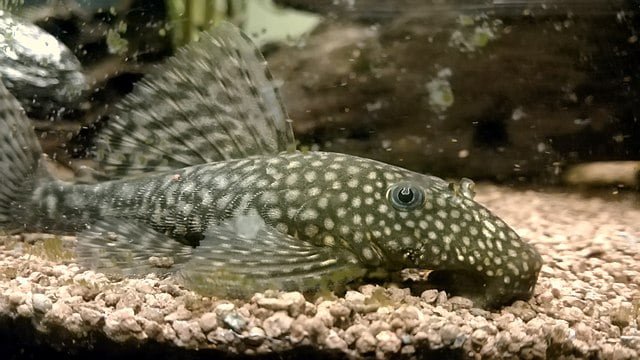
Natural habitat
Ancistrus fish are native to the river basins of South America, primarily the Amazon Basin, but they can also be found in rivers and streams of Panama, Guyana, Venezuela, Colombia, Ecuador, Peru, Bolivia, and Brazil. They inhabit a variety of freshwater environments, ranging from fast-flowing streams and acidic blackwater to more neutral whitewater rivers. They generally prefer well-oxygenated waters with plenty of hiding spots, such as rocks, submerged logs, and dense vegetation. These fish are predominantly benthic, spending most of their time at the bottom or attached to surfaces.
Introductions of Ancistrus fish have been reported in some areas outside their native range, such as in Florida (USA), highlighting the importance of not releasing aquarium pets into the wild.
Types of Ancistrus fish
The world of Ancistrus is surprisingly diverse, not only in wild species but also in varieties selectively bred in captivity. Below are some of the most popular types:
Common Ancistrus
- Appearance: The most frequently found variety. It has a dark brown or grayish base coloration, covered with small cream or pale yellow spots. The pattern may vary slightly.
- Origin: Usually Ancistrus sp., a mix of several species or a domesticated form.
- Availability and Price: Very common and generally inexpensive.
Albino Ancistrus
- Appearance: One of the most striking variants. Lacks dark pigmentation (melanin), resulting in a pale yellow or pinkish-orange body with red or pink eyes. The “bristles” are also light-colored.
- Origin: A genetic mutation that inhibits melanin production. The albino Ancistrus has been established through selective breeding.
- Care: Identical to the common Ancistrus, though some aquarists suggest they may be slightly more sensitive to bright light due to the lack of pigment in their eyes. Providing plenty of shaded areas is always a good practice.
- Availability and Price: Very common, slightly more expensive than the common variety.
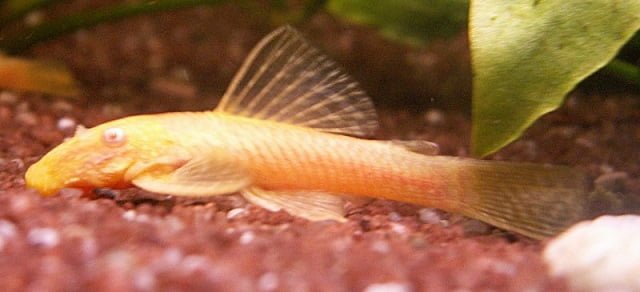
Super Red Ancistrus
- Appearance: Highly sought after for its intense, solid bright red-orange coloration covering the entire body. Unlike the albino Ancistrus, its eyes are dark (black or brown).
- Origin: The result of careful selective breeding, likely from individuals with reddish or orange tendencies. It is not a natural species, but rather a color strain developed in aquariums. The Super Red Ancistrus is an example of artificial selection.
- Care: Identical to the common Ancistrus.
- Availability and Price: Quite popular, generally more expensive than the common and albino varieties. Color intensity may vary between individuals.

Light Ancistrus (LDA08 / LDA100 – Gold Marble)
- Appearance: The light Ancistrus often refers to variants with a lighter background coloration (yellowish, golden, or light beige) and a dark spotted or mottled pattern (brown or black), creating a marbled or “golden” appearance. LDA08 and LDA100 are L-numbers (Loricariidae classifications) sometimes associated with these forms, though taxonomy can be complex and sometimes applies to different populations or species with similar appearances.
- Origin: They may be color variants of known species or specific geographical populations.
- Care: Generally the same as the common Ancistrus.
- Availability and Price: Less common than the previous types, with a variable price depending on the pattern quality and color clarity.
Other less common varieties
- Longfin Ancistrus (Veil): Available in common, albino, and super red varieties. Characterized by much longer, flowing fins. Requires special care to prevent fin damage.
- Calico Ancistrus: Features irregular orange/red, black, and white/yellow spots, similar to a “calico” koi fish.
- Snow White / Blue Eye Ancistrus: Leucistic variants (loss of most pigment but not complete like albinism), resulting in a white or very pale body with dark or blue eyes.
- Specific Wild Species: There are dozens of identified Ancistrus species (e.g., A. dolichopterus – L183 Starlight, A. ranunculus – L034 Medusa), each with unique patterns and sometimes slightly different requirements. These are more suitable for experienced aquarists.
Feeding
In their natural habitat, the Ancistrus diet consists of algae, periphyton, and detritus. Power (1984) described that the armored catfish Ancistrus spinosus grazes on substrates in a Panamanian stream, ingesting both attached algae and sediments deposited on surfaces.
However, in captivity, a varied and appropriate diet is essential for their long-term health. Although they are famous “algae eaters,” their natural diet is more omnivorous with a strong plant-based foundation. The captive Ancistrus diet should reflect this.
Diet Basics: Plant Matter & Algae
Natural Algae:
They will actively graze on algae growing on glass, rocks, and decorations. However, in a well-maintained aquarium, natural algae are rarely sufficient.
Prepared Food:
The main diet of Ancistrus should be high-quality commercial food formulated for herbivorous or omnivorous bottom-dwelling fish:
- Algae Wafers: Essential. Look for brands that use spirulina, chlorella, and other vegetables.
- Sinking Pellets: Vegetable-based or pleco-specific sinking pellets.
Fresh Vegetables: They love them! Offer 2-3 times per week:
- Zucchini: Favorite. Slightly blanch (boil for 1-2 minutes) or pierce with a fork to sink it. Remove leftovers after 24 hours.
- Cucumber: Similar to zucchini.
- Peas: Boiled and peeled.
- Spinach, Romaine Lettuce: Blanched.
- Sweet Potato (Yam), Carrot: Boiled until softened.
The Importance of Driftwood
As mentioned before, wood grazing is crucial for Ancistrus. They need the fiber (lignin, cellulose) for healthy digestion. Always ensure they have access to one or more pieces of aquarium-safe wood. A lack of wood can lead to digestive problems and may even cause them to gnaw on aquarium silicone seals.
Occasional Protein Supplements
Although their diet is mostly plant-based, they benefit from occasional proteins (1-2 times per week maximum):
- Tubifex, Bloodworms: Frozen or freeze-dried.
- Brine Shrimp, Mysis Shrimp: Frozen.
- High-quality omnivorous fish pellets.
⚠️ Caution! A diet too rich in protein can cause health issues, such as bloating. Ancistrus diets should always be plant-based.
Feeding Frequency & Amount
- Feed mainly at night or just before turning off the lights, as they are more active then.
- Offer an amount they can consume within a few hours. For vegetables, remove any uneaten portions the next day to prevent water contamination.
- It is better to feed small amounts frequently rather than large amounts all at once.
- A well-fed Ancistrus will have a slightly rounded belly, but not bloated.
Feeding Ancistrus Larvae
Şahin & Gürkan (2022) studied the optimal crude protein level for A. cirrhosus larvae, determining that a 40% protein content is most beneficial. Meanwhile, Romo (2010) evaluated the ideal protein level for A. temminckii, concluding that the best diet contains 25% crude protein and 3490 kcal EB/g PB.
Reproduction
In their natural habitat, Ancistrus reproduction occurs in holes, caves, or mud. Males clean the inside of the cavity using their suction mouth before the female inspects the nest. Breeding Ancistrus in captivity is relatively easy if proper conditions are provided and can be very rewarding.
Breeding Conditions
- Compatible Pair: You need at least one mature male and one female (typically over 1 year old or 7-8 cm in size).
- Spawning Caves: Essential! The male will choose a dark, narrow cave for spawning.
- Slate caves, PVC tubes (3-4 cm diameter, 15 cm long), coconut shells, or ceramic breeding caves work well.
- The male must be able to enter but still defend the entrance.
- Optimal Water Quality: Clean, well-oxygenated, and stable water parameters are crucial.
- Collazos & Arias (2009) evaluated the reproductive response of A. triradiatus to electrical conductivity changes, concluding that an 80 µS/cm conductivity resulted in:
- 75-92 eggs per female
- 93-99% fertility rate
- 101-hour incubation period (≈5 days)
- Collazos & Arias (2009) evaluated the reproductive response of A. triradiatus to electrical conductivity changes, concluding that an 80 µS/cm conductivity resulted in:
- Abundant, Varied Diet: A good plant-based diet with occasional protein supplements helps condition the fish for breeding.
Spawning Process
- Cave Selection: The male chooses a cave and meticulously cleans it.
- Courtship: The male tries to attract a mature female (usually with a swollen belly full of eggs) into his cave.
- Courtship includes flaring dorsal and caudal fins and escorting the female to the nest.
- Some chasing and displays may occur.
- Deniz et al. (2020) studied the breeding and development of A. dolichopterus in aquariums, using a ratio of 1 male to 2 females.
- The females laid an average of 39 eggs, with fertilization and hatching rates of 75.05% and 62.94%, respectively.
- Incubation lasted 105 hours.
- Egg Laying: If the female accepts, she enters the cave and lays 30-100 adhesive, orange-yellow eggs (sometimes more).
- Male Fertilization: The male follows and fertilizes the eggs.
- Female Expulsion: The male expels the female from the cave.
- Parental Care (Male): The male stays inside, fanning the eggs with his pectoral fins, keeping them clean and oxygenated, and defending the cave aggressively (even against the female).
Development and Hatching of the Eggs
- Incubation: The eggs take between 5 and 10 days to hatch, depending on the water temperature (warmer temperatures speed up the process).
- Fry: After hatching, the fry remain in the cave, attached to the walls or the father. They have a large yellow yolk sac, which they feed on for the first few days.
- Leaving the Cave: Once they have consumed most of their yolk sac (approximately 5-7 days after hatching), the young Ancistrus will begin venturing out of the cave in search of food.
Fry Care
Feeding: As soon as they start moving, they need food. They are tiny and require small-sized food:
- Fine algae and biofilm that naturally grow in the aquarium.
- Commercial powdered fry food.
- Finely crushed algae wafers.
- Soft vegetables (blanched zucchini) left in the tank.
- Newly hatched brine shrimp nauplii (optional, as a protein source).
Protection: In a community tank, fry are vulnerable to being eaten by other fish. To ensure a higher survival rate, you can:
- Move the cave with the father and eggs/fry to a separate breeding tank.
- Remove other fish from the main tank.
- Carefully siphon the fry once they leave the cave and transfer them to a breeding tank or a breeder box inside the main tank.
Water Quality: Fry are very sensitive to poor water quality. Keep the breeding tank clean with frequent, gentle water changes (using an air tube for siphoning if necessary).
Ancistrus Care
Providing a proper environment is essential for the health and well-being of your Ancistrus. Caring for an Ancistrus involves paying attention to several key factors in the aquarium.
Tank size
Although they do not grow as large as other plecos, Ancistrus still need space.
- Minimum Tank Size: For a single specimen, a tank of at least 75-80 liters (20 gallons) is recommended.
- Recommended Tank Size: A 100-120 liter (30-gallon) tank or larger is preferable, especially if keeping other fish or planning to breed them. A larger tank provides more stability in water parameters and more surface area for algae grazing.
- If keeping multiple Ancistrus, especially multiple males, a larger tank with plenty of visual barriers and hiding spots is necessary to reduce territorial aggression.
Substrate
A soft substrate like fine sand or smooth gravel is ideal, as they spend a lot of time at the bottom. Avoid sharp gravel that could injure their delicate belly or mouth.
Filtration and Water Flow
Ancistrus, like most catfish, produce a considerable amount of waste. Therefore, strong filtration is essential.
- Filtration: A canister filter or a high-quality hang-on-back filter capable of moving at least 4-5 times the aquarium’s volume per hour is recommended.
- Water Flow: While some species come from fast-moving waters, most aquarium Ancistrus adapt well to moderate flow. Good water movement helps with oxygenation.
- Regarding this, Crowder and Dzialowski (2024) reported that developing A. cirrhosus can take advantage of aerial environments once they reach 3 cm in length and 2 g in weight when exposed to aquatic hypoxia; before this size, the fish may succumb to severe aquatic hypoxia without the ability to breathe air.
Decoration and Hiding Spots
This is a crucial aspect of Ancistrus care. They are nocturnal and shy by nature, needing safe places to hide during the day or when they feel threatened.
- Driftwood: Essential! Not only does it provide hiding spots, but it is also an important part of their diet, as they graze on wood to obtain lignin and cellulose, which aid digestion. Ensure you use aquarium-safe woods (such as Mopani, Malaysian driftwood, etc.).
- Caves: A must-have, especially for breeding. Suitable options include slate caves, PVC tubes, coconut shells, or ceramic pleco caves. There should be at least one cave per Ancistrus, and more if multiple males are kept.
- Rocks and Plants: Stacked rocks (secured to prevent collapse) and sturdy plants (like Anubias, Java Fern, Vallisneria) also offer shelter and surfaces for algae and biofilm growth.
Lighting
Ancistrus prefer dim to moderate lighting. If you have high-light plants, ensure plenty of shaded areas with driftwood, tall rocks, or floating plants. Their peak activity occurs at dusk and dawn.
Table 01. Water Quality Technical Sheet for Keeping Ancistrus Healthy.
| Parameter | Range |
|---|---|
| Aquarium Volume | 100 liters |
| Temperature | 23 to 27°C (73-81°F) |
| pH | 6.5 – 7.5 |
| General Hardness (GH) | 5 – 15 dGH |
| Carbonate Hardness (KH) | 4 – 8 dKH |
| Ammonia (NH3/NH4⁺) | 0 ppm |
| Nitrite (NO2⁻) | 0 ppm |
| Nitrate (NO3⁻) | 20-40 ppm |
| Water Changes | 25-50% of the water weekly |
Compatibility
Understanding your Ancistrus fish’s behavior will help you choose suitable tankmates and create a harmonious environment.
General Temperament
- Peaceful with other species: Ancistrus are generally excellent community fish and peaceful with most other aquarium inhabitants. They tend to ignore fish swimming in the mid and upper levels.
- Territorial with their own species: They can be territorial with each other, especially adult males. Males will aggressively defend their chosen cave or territory, particularly if females are present or space is limited. If keeping multiple Ancistrus, ensure a large tank with plenty of caves and hiding spots. A ratio of one male per two or three females usually works better than keeping multiple males together, unless the tank is very large (over 200 liters).
Activity
Ancistrus are primarily nocturnal and crepuscular (active at dawn and dusk). During the day, they usually remain hidden in caves or under driftwood but may come out to feed if accustomed to a daytime feeding schedule.
Tankmates
Good options:
- Most Tetras, Rasboras, Danios
- Rainbowfish
- Corydoras (although they share bottom space, they usually ignore each other)
- Peaceful Gouramis
- Pencilfish
- Hatchetfish
- Livebearers (Guppies, Mollies, Platies, Swordtails) – as long as water parameters are compatible
- Peaceful dwarf cichlids (Ramirezi, Apistogramma) – with enough space and hiding spots
Options to consider with caution:
- Very small or delicate fish: A large Ancistrus could stress or accidentally harm them.
- Other territorial bottom dwellers: Conflicts over space may arise.
- Small shrimp (Neocaridina, Caridina): Adults are usually safe, but Ancistrus may accidentally eat baby shrimp while grazing. Larger Amano shrimp are generally safe.
Bad options:
- Very large and aggressive fish: They may harass or injure the Ancistrus.
- Other large, territorial Loricariids: Intense competition for resources and space.
- Crayfish or lobsters: They may harm the Ancistrus.
Diseases Affecting Ancistrus
Although Ancistrus are generally hardy fish, they can be susceptible to common aquarium diseases, especially if their care conditions are not optimal. Caring for an Ancistrus also means recognizing and preventing health problems.
Common Diseases
- Ich (White Spot Disease): Caused by the parasite Ichthyophthirius multifiliis, appearing as small white spots on the body and fins. Treat with specific medications and often by slightly raising the temperature.
- Fungal Infections: Appear as white or gray cotton-like patches, often at a previous injury site. Treat with antifungal medications.
- Bacterial Infections: May cause fin rot (frayed fins, red edges), ulcers, or hemorrhagic septicemia (red streaks). Require treatment with specific antibiotics.
- Intestinal Parasites: Symptoms include weight loss, white stringy feces, and lethargy.
- Bloat (Swelling): Severely bloated abdomen, often due to an improper diet (too much protein, lack of fiber/wood) or water quality issues. Difficult to treat.
Prevention
Most diseases can be prevented by maintaining a healthy environment:
- Maintain Excellent Water Quality: Regular water changes, good filtration, and stable parameters.
- Provide a Proper Diet: A varied diet with a plant-based focus and constant access to driftwood. Avoid overfeeding.
- Reduce Stress: Offer enough hiding places, avoid overcrowding, select compatible tankmates, and minimize handling.
- Quarantine: Essential! Keep any new fish (including Ancistrus) in a separate quarantine tank for 4-6 weeks before introducing them to your main aquarium. This allows for disease observation and treatment without affecting other fish.
- Slow Acclimatization: When introducing a new Ancistrus, slowly acclimate it to your aquarium’s temperature and water parameters to minimize shock.
Conclusion
The Ancistrus catfish has rightfully earned its place as one of the most beloved and beneficial aquarium fish. Whether you choose the classic brown Ancistrus, the striking Albino Ancistrus, the vibrant Super Red Ancistrus, or the elegant Clear Ancistrus, you’re adding a fascinating and useful member to your aquatic community.
Remember, providing them with a suitable environment (space, hiding spots, driftwood), maintaining excellent water quality, and offering a varied, plant-rich diet are the keys to enjoying the company of these wonderful catfish for many years. The Ancistrus is not just a cleaner but a valuable and charismatic addition to any aquarist’s tank.
References
Collazos-Lasso, L. F., & Arias-Castellanos, J. A. (2009). Estimulación a la maduración final y el desove de Ancistrus triradiatus. Orinoquia, 13(1), 14–19. https://doi.org/10.22579/20112629.225
Crowder, L.W., Dzialowski, E.M. Development of facultative air breathing in bristlenose plecos (Ancistrus cirrhosus). Environ Biol Fish 107, 867–876 (2024). https://doi.org/10.1007/s10641-024-01579-2
De Oliveira, R.R., Feldberg, E., Dos Anjos, M.B. and Zuanon, J. (2009), Mechanisms of chromosomal evolution and its possible relation to natural history characteristics in Ancistrus catfishes (Siluriformes: Loricariidae). Journal of Fish Biology, 75: 2209-2225. https://doi.org/10.1111/j.1095-8649.2009.02450.x
DENİZ, M., TANRIKUL, T. T., KARADAL, O., DİNÇTÜRK, E., & KARADUMAN, F. R. (2020). A preliminary study on reproduction and development of bushymouth catfish (Ancistrus dolichopterus) in aquarium conditions. Journal of Limnology and Freshwater Fisheries Research, 6(3), 231-237.
Novák, J., Hohl, D., Stuchlík, M., Hofmann, J., Tlusty, M. F., Barroso Magalhães, A. L., Maceda-Veiga, A., Akmal, S. G., Yue, G. H., Kumkar, P., Marr, S. M., Sara, J. R., Stern, N., Rhyne, A. L., Furse, J. M., Kalous, L., & Patoka, J. (2025). Revisiting the History of Ornamental Aquaculture in Europe to Understand the Benefits and Drawbacks of Freshwater Fish Imports. Reviews in Aquaculture, 17(2), e13008. https://doi.org/10.1111/raq.13008
Power, M.E. The importance of sediment in the grazing ecology and size class interactions of an armored catfish, Ancistrus spinosus. Environ Biol Fish 10, 173–181 (1984). https://doi.org/10.1007/BF00001124
Romo Erazo, Leidy Diana (2010) Respuesta de ancistrus temminckii, (valenciennes, 1840) (pisces: loricaridae), a dos dietas con diferente nivel de proteína y energia para la etapa de levante. Informe final de Trabajo de Grado. Universidad de Nariño – SIRED, Pasto, Colombia.
Şahin, T., & Gürkan, M. (2022). Effects of dietary protein level on growth, histology and digestive enzyme activities of ornamental fish Ancistrus cirrhosus. Aquaculture Research, 53, 6700– 6710. https://doi.org/10.1111/are.16138
Editor at the digital magazine AquaHoy. He holds a degree in Aquaculture Biology from the National University of Santa (UNS) and a Master’s degree in Science and Innovation Management from the Polytechnic University of Valencia, with postgraduate diplomas in Business Innovation and Innovation Management. He possesses extensive experience in the aquaculture and fisheries sector, having led the Fisheries Innovation Unit of the National Program for Innovation in Fisheries and Aquaculture (PNIPA). He has served as a senior consultant in technology watch, an innovation project formulator and advisor, and a lecturer at UNS. He is a member of the Peruvian College of Biologists and was recognized by the World Aquaculture Society (WAS) in 2016 for his contribution to aquaculture.
